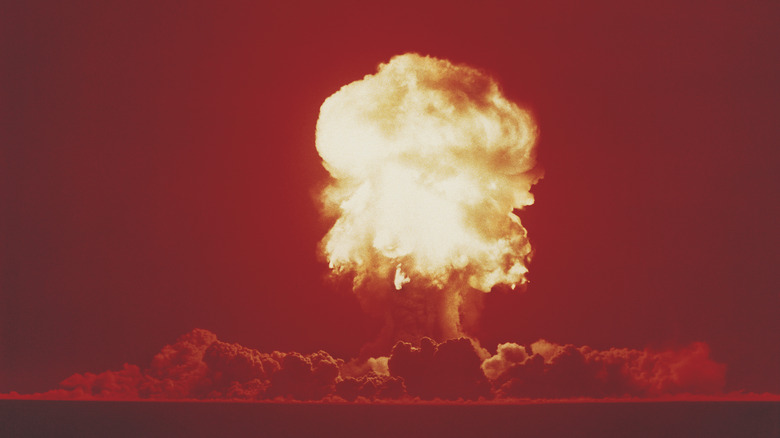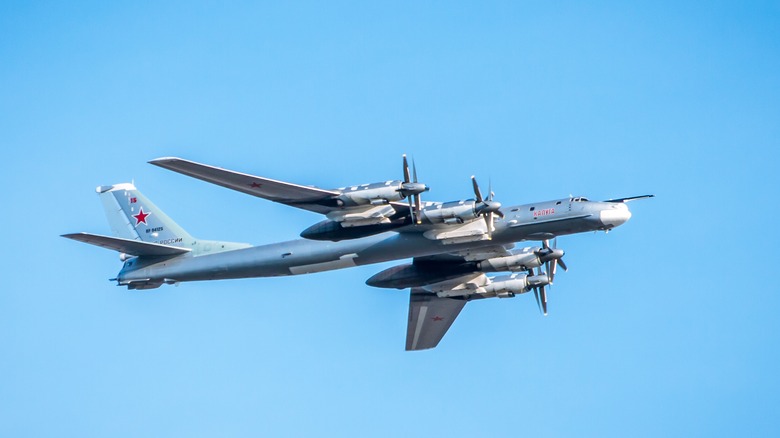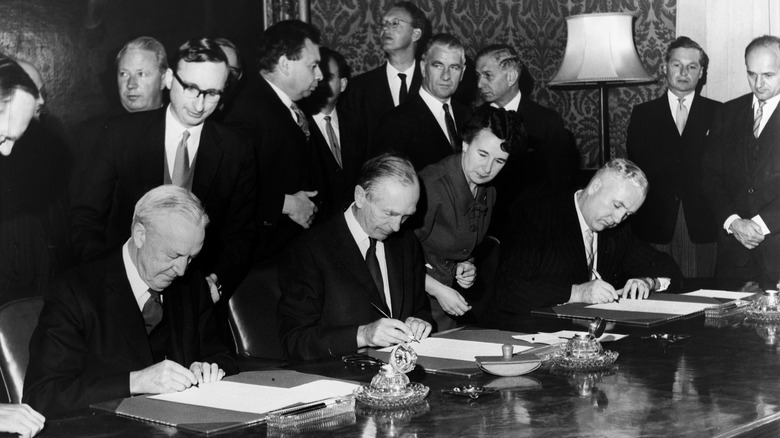Tsar Bomba: The Story Behind The Largest Nuclear Bomb Ever Detonated
In Christopher Nolan's latest epic movie Oppenheimer, we see Robert Oppenheimer, the so-called "father of the atom bomb," struggling with the moral questions raised by his world-shaking invention. It will probably never be known how many people were killed in the wartime deployments of nuclear weapons over Japan in 1945, but estimates range between 110,000 and 210,000 – a fearsome death toll, inflicted by just two bombs.
For all of their destructive power, however, those early bombs were tiny compared to later devices. The bombs dropped on Hiroshima and Nagasaki exploded with a force equivalent to roughly 15 and 20 kilotons of TNT, respectively. Ultimately, the insane postwar "arms race" between the US and Soviet Russia would see a new generation of vastly more powerful "thermonuclear" weapons developed that — if used in anger — would have transformed the world forever.
Foremost among those "super" weapons was Product Code 202 (in Russian: Izdeliye 202), better known by its later Western nickname, "Tsar Bomba." Designed as a 100-megaton bomb, Tsar Bomba was considered too dangerous to test at its full destructive potential. Instead, for its one and only test in 1961, Soviet scientists "downrated" the Tsar Bomba to around 50 megatons by swapping out uranium for lead in at least one of the bomb's stages. Even so, the resulting detonation was enormous, resulting in the most powerful human-made explosion ever recorded. Ironically, it may also have made the world a slightly safer place.
The Explosion
When Major Andrei Durnovstev climbed into his modified Tu-95V on the morning of October 30th, 1961, with the Tsar Bomber onboard, he knew that he and his crew only had a 50/50 chance of survival. The bomb was gigantic. It measured 26 feet in length and weighed 27 metric tons, (59,525 lbs). It was attached to a parachute that alone weighed 1,800 lbs, designed to slow the bomb's descent for long enough for Durnovstev and his crew to reach (it was hoped) a safe distance of at least 30 miles before it went off.
50/50 isn't great odds, but had the Tsar Bomba been tested at its maximum theoretical yield of 100 megatons, Durnovstev would certainly have been doomed. Soviet scientists estimated that a single detonation would have resulted in dangerous and widespread levels of radioactive fallout, and would have destroyed the plane that dropped the bomb.
The Tsar Bomba exploded with a destructive power equivalent to more than 1500 times that of the weapons dropped over Japan in 1945. It created a fireball more than 8 kilometers wide, and the heat from the explosion was intense enough to cause third-degree burns at a distance of more than 60 miles from the detonation point. The shock wave was felt from 430 miles away, and thanks to "atmospheric focusing," it was reported that windows shattered as far away as Norway and Finland. The shock wave traveled around the earth three times before it eventually dissipated. Durnovstev and his crew survived, but only after being pummelled by the shock wave, which caused their plane to drop by more than 3,000 feet before control was regained. The paintwork on a secret US spy plane, covertly observing the test from nearby, was scorched.
The Aftermath
There are three ironies surrounding the Tsar Bomba. The first is that due to the modifications that were made to reduce its destructive power, fallout was reduced by an estimated 97%, making it among the "cleanest" nuclear weapons ever tested.
The second irony is that despite its fearsome destructive power, the Tsar Bomba was almost useless as a weapon of war. In terms of the radius of destruction, despite weighing roughly ten times as much, a 100-megaton bomb is "only" about twice as damaging as a 10-megaton device. Furthermore, such a gigantic bomb could only be air-dropped from a highly vulnerable aircraft, and it would have been a suicide mission for the crew. Following the insane logic of the cold war, the Tsar Bomba was a propaganda tool created to intimidate the US under the newly-elected John F. Kennedy. It wasn't meant to be a practical weapon; it was a flex.
The third irony is that after the Tsar Bomba was detonated, international condemnation and a growing uneasiness on the part of those involved in weapons development actually made the world slightly safer. In 1963, the landmark Partial Nuclear Test Ban Treaty was signed by the United States, the U.S.S.R., and Great Britain, banning atmospheric testing of nuclear weapons. The treaty was ratified and signed in October 1963, 46 days before John F Kennedy's assassination. Soviet physicist Andrei Sakharov, the Tsar Bomba's lead designer, became one of the leading voices advocating arms control. He was awarded a Nobel Peace Prize in 1975.


